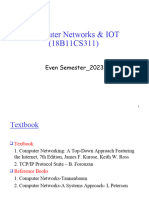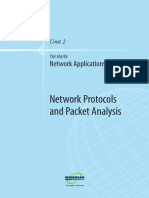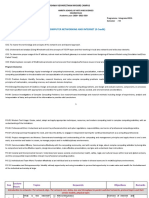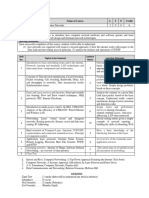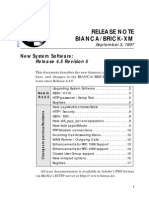Course Policy
Course Policy
Uploaded by
UTSAV KHANDELWALCopyright:
Available Formats
Course Policy
Course Policy
Uploaded by
UTSAV KHANDELWALCopyright
Available Formats
Share this document
Did you find this document useful?
Is this content inappropriate?
Copyright:
Available Formats
Course Policy
Course Policy
Uploaded by
UTSAV KHANDELWALCopyright:
Available Formats
ANNEXURE – 16
Nirma University
Institute of Technology
Computer Engineering Department
Course Policy Document
Integrated B.Tech.(CSE)-MBA
Trimester: VI, Academic Year: 2021-22, Term: Even
Course Code & Name : 2CS605
Credit Details : 2-0-2-3 (L-T-P-C)
Course Co-ordinator : Dr. Rohit Pachlor (Also a course faculty)
Contact No. & Email : 7770081610, rohit.pachlor@nirmauni.ac.in
Office : 11th floor faculty area
Visiting Hours : 8:45 AM – 4:00 PM
Course Faculty : Dr. Rohit Pachlor (Theory and Lab)
Mrs. Riya Kakkar, Mrs. Shivani Pandya (Lab)
Contact No. & Email : rohit.pachlor@nirmauni.ac.in
21ftphde56@nirmauni.ac.in
21ftphde57@nirmauni.ac.in
Office : 11th floor PhD student area
Visiting Hours : 8:45 AM to 4:00 PM
Introduction to Course:
The entire world has become very small thanks to evolution in telecommunication and
networking. We use large number of applications for communication. E-mail, Whatsapp
and Facebook are few of those. As a student of Computer Engineering, one must know
internal details of how applications/devices communicate with each other. The objective
of this course is exactly the same. This course discusses issues and protocols involved in
packet transfer over a network or Internet.
Course Learning Outcomes:
At the end of the course, students will be able to -
1. Summarize the functionality of different layers of computer network
architectures.
2. Analyze protocols related to various layers.
3. Design computer network configurations
4. Explain the significance of various fields of protocol headers
Syllabus Teaching
Hours
Unit I
Introduction: Use of Computer Networks, Connecting devices,
02
Networks and its types, network standards. Network Hardware,
Network Software, OSI and TCP/IP Reference Model.
Unit II 06
Data Link Layer: Introduction and link layer services, Two sublayers,
link layer addressing, data link layer protocols, multiple-access
protocols: Aloha, CSMA, Ethernet protocols and types of Ethernet.
Unit III 07
Network Layer: Design Issues, packet switching, Routing Algorithms:
Shortest Path Routing, Flooding, Distance Vector Routing, Link State
Routing, Congestion Control Algorithms, Quality of Service, Example
protocols: IPv4 and IPv6, addressing, subnetting, IP Datagram Format,
Fragmentation
Unit IV: 03
Transport Layer: Transport Service, transport layer protocols for flow
control, Congestion Control, Example protocols: UDP, TCP.
Unit V 02
Application Layer: The Domain Name System, Electronic Mail, World
Wide Web, HTTP, FTP, Content delivery.
(*)Self-Study:
The self-study contents will be declared at the commencement of semester. Around
10% of the questions will be asked from self-study contents.
Laboratory Work:
Laboratory work will be based on the above syllabus with minimum 10 experiments
to be incorporated.
Suggested Readings/References:
1. Andrew S. Tanenbaum, Computer Networks, PHI Publication
2. Behrouz Forouzan, Data Communication Networking, TMH Publication
3. James Kurose and Keith Ross, Computer Networking: A Top-Down Approach,
Pearson
4. Behrouz Forouzan, TCP/IP Protocol suite, TMH Publication
5. William Stallings, Data and Computer Communication, Pearson
6. Jim Kurose, Computer Networking: A top-down approach, Pearson
L=Lecture, T=Tutorial, P=Practical, C=Credit
Practical Aim of the practical No. of Mapped
No Hours CLO
1 Configuration of LAN using Hub and Switch in Cisco 2 1,3
Packet Tracer.
Assign IP Address
Ethernet Crossover and straight through cable
Basics of network commands: ping, ipconfig.
2 Implementation of various topologies in Cisco Packet 2 1,2,3
Tracer.
Basics of network commands: netstat, traceroute,
nslookup, finger, fping, and Arp
3 Explore Packet capture tool (Wireshark) to capture 2 1,2
and analyze various types of network packets
4 Data Link Layer (Frame Generation): 2 1,2
Write a program to read a stream of data from data
file to create frames by implementing bit stuffing, bit
destuffing, character stuffing, character destuffing .
5 A. Implement following error detection 2 1, 2,4
techniques:
I. Checksum
II. CRC
B. Implement error correction using hamming
code concept.
6 Configure Virtual LAN using Packet Tracer. 2 1,3
7 Configure Wirless LAN using Packet Tracer. 2 1,3
8 Implementation of Subnetting: Design multiple 2 2,3,4
subnets using Packet Tracer with suitable number of
hosts. Make a plan to assign static IP addressing
across all subnet to understand Subnetting.
9 Simulate Static and Dynamic routing using Packet 2 2,3,4
Tracer.
10 Configure FTP, DHCP, DNS, Web and Mail server 2 1,2,3
using Packet Tracer.
Total 20
Laboratory details: (List of Experiments, Schedule, assessment policy)
Assessment Policy: Practical evaluation will be based on following criteria:
• Plagiarism
• Implementation
• Output
• Timeliness
Lesson Plan
Lecture Topics Mapping
No. with CLO
1 Introduction to the course, reading materials and evaluation 1
methods
UNIT 1 – Introduction (02 Lectures)
2 Network Hardware : Personal Area Networks, Local Area 1
Networks, Metropolitan Area Networks, Wide Area
Networks, Internetworks
Network Software: Protocol Hierarchies, Design Issues of
Layers, Connection Oriented v/s Connectionless services,
Service Primitives
3 OSI Reference Model : Description of all 7 layers 1
TCP/IP Reference Model, Comparison of OSI and TCP/IP
1
UNIT 2 – Data Link Layer (06 Lectures)
4 Data Link Layer Design Issues: Services Provided to Network 1
Layer, Framing, Error Control, Flow Control
5 Sublayers: LLC and MAC, Elementary Data Link Protocols 1,2
6 Simplex Stop and Wait for Noiseless and Noisy Channels, 1,2
Sliding Window Protocols: Go back N, Selective Repeat
7 MAC protocols: ALOHA and its variants, CSMA and its 1,2
variants.
9 Ethernet Protocols and Types of Ethernet 1,2
UNIT 3 – Network Layer (07 Lectures)
10 Network Layer Design Issues: Store and Forward Concept, 3
Services.
11 Routing Algorithms: Shortest Path Routing, flooding 2, 3
12 Routing Algorithms: Distance Vector Routing: Principle, count 2, 3
to infinity problem and it’s solutions, Link State Routing
13 Congestion Control Algorithms: Traffic-aware routing, 2, 3
admission control, traffic throttling, load shedding
14 Quality of Service: Application Requirements, Traffic 2, 3
shaping, packet scheduling
15 IPV4 vs IPV6 Addressing, Subnetting. 2, 3
16 IP Datagram format and Fragmentation. 2,3
UNIT 5: Transport Layer (3 Lectures)
17 Transport Service: Services provides, Flow control protocols. 2, 3
18 Congestion Control, TCP and UDP 2, 3
19 TCP and UDP 2,3
UNIT 5: Application Layer (03 Lectures)
20 Domain Name System: Name space, Domain Resource Records, 3,4
Name Servers , Electronic Mail,
21 WWW, HTTP, FTP, Content Deilvery 3,4
Total 21
Course Assessment Schemes:
Continuous Evaluation: Class Test/ (3 Quizzes each of Total 50 Marks), Sessional Exam,
Lab Work Evaluation
Semester End Evaluation: LPW Viva Voce, Semester End Examination (SEE)
Component wise Continuous Evaluation & Semester End Examination
weightage:
Assessment CE LPW SEE
scheme
3 Assignments of total Mid Term Continuous TEE
50 Marks Exam Evaluation
50% 50% 75% 25% 100%
Teaching-learning methodology:
• Lectures: Board Teaching, PPT.
• Laboratory: Network design, Network programming, Simulation
• University campus network demonstration
Active learning techniques:
• One-minute paper (Clearest/Muddiest point), What I liked the most that helped
me in learning
Types of Special/Innovative Assignments, Term Papers, mini Projects
etc.
TBD
Course Material:
Following materials are available on LMS:
• Course Policy
• PPTs, Notes, other Material
• Assignments, Tutorials, Lab Manuals
• Question bank
• Web-links, Blogs, Video Lectures, Journals
• Animations /Simulations, Software’s
• Advanced topics
• Industries/Organizations
Course Outcome Attainment:
• Use of formal evaluation components of continuous evaluation, laboratory work,
semester end examination
• Informal feedback during course conduction
• Surveys & Peer observation
You might also like
- 4.3.2.7 CommandsDocument3 pages4.3.2.7 CommandsStill ggNo ratings yet
- Nicira - It Is Time To Virtualize The NetworkDocument9 pagesNicira - It Is Time To Virtualize The Networkcsp_675491No ratings yet
- Presentation On Tcp/Ip Reference ModelDocument12 pagesPresentation On Tcp/Ip Reference ModelRosemelyne Wartde100% (1)
- CSF303Document4 pagesCSF303vanshikaNo ratings yet
- CCN SyllabusDocument3 pagesCCN Syllabusraomanusha3No ratings yet
- IT4030 - Computer NetworksDocument5 pagesIT4030 - Computer Networksmakanijenshi2409No ratings yet
- Computer NetworkDocument3 pagesComputer NetworkNeela RaiNo ratings yet
- Cse3006 Computer-Networks LTP 1.0 1 Cse3006 R1Document3 pagesCse3006 Computer-Networks LTP 1.0 1 Cse3006 R1hackedNo ratings yet
- Computer NetworksDocument2 pagesComputer NetworksMohan GollaNo ratings yet
- Bitszc 481Document3 pagesBitszc 481rvtymcaNo ratings yet
- AI2003 Computer NetworkDocument4 pagesAI2003 Computer NetworkVaradNo ratings yet
- Computer NetworksDocument3 pagesComputer Networksnegas77321No ratings yet
- Bece401l Computer-Communications-And-Networks TH 1.0 0 Bece401lDocument3 pagesBece401l Computer-Communications-And-Networks TH 1.0 0 Bece401lAnkit DhangNo ratings yet
- 08 CMP344 Computer NetworksDocument6 pages08 CMP344 Computer Networkshafasit984No ratings yet
- CBS3001 - Computer-Networks - Eth - 1.0 - 63 - CBS3001 - 59 AcpDocument2 pagesCBS3001 - Computer-Networks - Eth - 1.0 - 63 - CBS3001 - 59 AcpkrishnamoorthyeceNo ratings yet
- 1 SyllabusDocument3 pages1 SyllabusThumma ReddyNo ratings yet
- CE505-N Computer NetworksDocument4 pagesCE505-N Computer NetworksabcNo ratings yet
- CE505-N Computer NetworksDocument4 pagesCE505-N Computer NetworksSasta LalaNo ratings yet
- CNND SyllabusDocument4 pagesCNND Syllabusmaaz.ai.17101710No ratings yet
- CACS 303 Computer Networking BCA 5th SemDocument3 pagesCACS 303 Computer Networking BCA 5th SemChess BlogsNo ratings yet
- CN SyllabusDocument3 pagesCN Syllabustanmay sonawaneNo ratings yet
- Swe2002 Computer-Networks Eth 1.0 37 Swe2002Document4 pagesSwe2002 Computer-Networks Eth 1.0 37 Swe2002Naveen VnvNo ratings yet
- Computer Networks and Tcp/IpDocument21 pagesComputer Networks and Tcp/IpKARTHIKEYAN GNo ratings yet
- CSE461 Syllabus 2015Document3 pagesCSE461 Syllabus 2015Phạm Ngọc HảiNo ratings yet
- SYLLABUSDocument2 pagesSYLLABUSAsha ViswanadhNo ratings yet
- Comp 327035225Document4 pagesComp 327035225amritpalmrockNo ratings yet
- UndefinedDocument3 pagesUndefinedharsha145.appikatlaNo ratings yet
- Syllabus and StructureDocument90 pagesSyllabus and Structure1032210521No ratings yet
- CN & IOT - Module 1 - IntroductionDocument123 pagesCN & IOT - Module 1 - Introductionpalakkhurana012No ratings yet
- 7etssyll (1)Document5 pages7etssyll (1)kiran bk453No ratings yet
- (1341)Document2 pages(1341)soniyash4095No ratings yet
- Network Applications U2Document52 pagesNetwork Applications U2hdriNo ratings yet
- 2023 24 ODD CE262 DCN SyllabusDocument5 pages2023 24 ODD CE262 DCN Syllabuspoojaramani8872No ratings yet
- Computer NetworksDocument10 pagesComputer Networkspaperprep3No ratings yet
- CCN Syllabus BAMU ETCDocument2 pagesCCN Syllabus BAMU ETCanilbNo ratings yet
- Data Comminication and Anetworking Course Out LineDocument5 pagesData Comminication and Anetworking Course Out Lineguddinan makureNo ratings yet
- Lecture Plan (CSC305 - CN Theory)Document2 pagesLecture Plan (CSC305 - CN Theory)cokope9857No ratings yet
- Data Communication & NetworkingDocument3 pagesData Communication & NetworkingAAYUSH RATHODNo ratings yet
- Cse301-Introduction To Computer NetworksDocument2 pagesCse301-Introduction To Computer NetworksBanoshree BoseNo ratings yet
- Vi SemesterDocument8 pagesVi Semesterdarshika artistoNo ratings yet
- Computer Communication NetworksDocument2 pagesComputer Communication NetworksMahalaxmi GinnamNo ratings yet
- CN Combined MergedDocument487 pagesCN Combined MergedLalitNo ratings yet
- IT-313 (IAP) Course OutlineDocument5 pagesIT-313 (IAP) Course Outlineinbasaat talhaNo ratings yet
- Syllubus For Data Networks and ProtocolsDocument2 pagesSyllubus For Data Networks and ProtocolsSELVAKUMAR RNo ratings yet
- 1 Introduction To CNDocument23 pages1 Introduction To CNabiskarpokhrel999No ratings yet
- Communication NetworkDocument2 pagesCommunication NetworkDr. Lokesh Kumar BramhaneNo ratings yet
- Computer Network SyllabusDocument4 pagesComputer Network SyllabusSanjay Shrestha100% (1)
- SyllabusDocument4 pagesSyllabusnsethiyaNo ratings yet
- EC407 Computer Communication-Ktunotes - inDocument3 pagesEC407 Computer Communication-Ktunotes - inbilbobaggingsNo ratings yet
- 18ca301 Advanced Computer Networks and Internet 3-0-1-4Document8 pages18ca301 Advanced Computer Networks and Internet 3-0-1-4preetham rNo ratings yet
- School of CET TY SyllabusDocument70 pagesSchool of CET TY SyllabusDevenNo ratings yet
- CN LessonPlan 2024Document3 pagesCN LessonPlan 2024pkpfiles1001No ratings yet
- ComputerNetworks Outline v1.1Document4 pagesComputerNetworks Outline v1.1Hinan BilalNo ratings yet
- Computer Networks PDFDocument2 pagesComputer Networks PDFKIRTI ROHIRANo ratings yet
- 1-Syllabus, CO, ECO, Rubrics Discussion-04!01!2024Document2 pages1-Syllabus, CO, ECO, Rubrics Discussion-04!01!2024vedhatrioathi100No ratings yet
- Lec01 - Data Communications BUE 2021-2022Document28 pagesLec01 - Data Communications BUE 2021-2022omarNo ratings yet
- CN Lec#1Document9 pagesCN Lec#1tahirsabatahir837No ratings yet
- CSC 2201 - Computer Networking-Out LineDocument8 pagesCSC 2201 - Computer Networking-Out LineMd Rubaiyat BhuiyanNo ratings yet
- BoS 4th Sem BCDocument16 pagesBoS 4th Sem BCaayush26bc002No ratings yet
- Mcse505l - Computer-Networks - TH - 1.0 - 71 - Mcse505l - 67 AcpDocument2 pagesMcse505l - Computer-Networks - TH - 1.0 - 71 - Mcse505l - 67 AcpkrishnamoorthyeceNo ratings yet
- Data Communication Networks (Ece-601)Document2 pagesData Communication Networks (Ece-601)कृष्णा कुमार कश्यपNo ratings yet
- 2 0 2 3 4 CSE18R273/Operating Systems Program Core Integrated CourseDocument4 pages2 0 2 3 4 CSE18R273/Operating Systems Program Core Integrated CourseMr. M. Raja CSE STAFFNo ratings yet
- Chapter 4.1 Basic Call Procedure (ED01 - 53 - EN)Document53 pagesChapter 4.1 Basic Call Procedure (ED01 - 53 - EN)quaderbtech06No ratings yet
- Connection Log - PreviousDocument72 pagesConnection Log - PreviousSergio BranNo ratings yet
- 2023 Roadmap PPT 20230117Document5 pages2023 Roadmap PPT 20230117majdizarradNo ratings yet
- Juniper InterAS OptionCDocument12 pagesJuniper InterAS OptionCAlex MachadoNo ratings yet
- Afficher Les Cartes Reseaux:: Root@debiantpeval: # Ifconfig RésultatDocument9 pagesAfficher Les Cartes Reseaux:: Root@debiantpeval: # Ifconfig RésultatMalick DiattaNo ratings yet
- BGP Multipath Load Sharing For Both eBGP and Ibgp in An MPLS-VPNDocument14 pagesBGP Multipath Load Sharing For Both eBGP and Ibgp in An MPLS-VPNSandi WanderanNo ratings yet
- CCNA 200-125 Certification Practice Exam Answers Update New QuestionsDocument49 pagesCCNA 200-125 Certification Practice Exam Answers Update New Questionssiddig02No ratings yet
- Mobile ComputingDocument5 pagesMobile ComputingNitheesh RaviNo ratings yet
- EX7Document14 pagesEX7GuzganShobolanNo ratings yet
- Building Web Application Using APIDocument15 pagesBuilding Web Application Using APIJeremy LilaNo ratings yet
- Comparison of Communication ProtocolDocument2 pagesComparison of Communication Protocolvigneshwaran100% (2)
- B Ce Xe-313s-Asr920-Book Chapter 01Document40 pagesB Ce Xe-313s-Asr920-Book Chapter 01Marcos SanchezNo ratings yet
- WGA Setup For WindowsDocument15 pagesWGA Setup For Windowsdaniliuc_aNo ratings yet
- ZTE-9806 DSLAM ConfigurationDocument3 pagesZTE-9806 DSLAM ConfigurationNélio Soares de FreitasNo ratings yet
- RMI & RPCDocument9 pagesRMI & RPCHARISH GuptaNo ratings yet
- 2.9.1 Packet Tracer - Basic Switch and End Device Configuration Jorge MendezDocument5 pages2.9.1 Packet Tracer - Basic Switch and End Device Configuration Jorge MendezJorge MéndezNo ratings yet
- University of Mumbai: Syllabus For T.Y.B.Sc. Programme: B.SCDocument61 pagesUniversity of Mumbai: Syllabus For T.Y.B.Sc. Programme: B.SCMaheshNo ratings yet
- (User Manual) USR G771 E User Manual - 1687230153Document44 pages(User Manual) USR G771 E User Manual - 1687230153ftonelloNo ratings yet
- Appendix B: Modbus Protocol B.4 Modbus Data: 1601-0800-A1 F650 Digital Bay Controller B-19Document250 pagesAppendix B: Modbus Protocol B.4 Modbus Data: 1601-0800-A1 F650 Digital Bay Controller B-19hiếuNo ratings yet
- OSI WorksheetDocument4 pagesOSI WorksheetArife Muse BorchaNo ratings yet
- Streaming Audio and Video: Presented by Mostafa MonwarDocument21 pagesStreaming Audio and Video: Presented by Mostafa MonwarImran CHNo ratings yet
- Data Communication & Computer Networks: Dr. Rehan QureshiDocument32 pagesData Communication & Computer Networks: Dr. Rehan QureshiOsama FarooquiNo ratings yet
- Release Note Bianca/Brick-Xm: New System Software: Release 4.5 Revision 5Document18 pagesRelease Note Bianca/Brick-Xm: New System Software: Release 4.5 Revision 5niko67No ratings yet
- 2019 User Services PlatformDocument12 pages2019 User Services PlatformPantau TertibNo ratings yet
- -Trình duyệt chạy bản HTTP 1.1 -Cũng là phiên bản HTTP 1.1: Wireshark LabDocument3 pages-Trình duyệt chạy bản HTTP 1.1 -Cũng là phiên bản HTTP 1.1: Wireshark LabNam Nguyễn VănNo ratings yet
- F3a25 Lte&Evdo Router SpecificationDocument4 pagesF3a25 Lte&Evdo Router SpecificationmandyfourfaithNo ratings yet
- A Taxonomy of Communication Networks: Y. Richard Yang 9/7/2009Document43 pagesA Taxonomy of Communication Networks: Y. Richard Yang 9/7/2009amnapaNo ratings yet




























